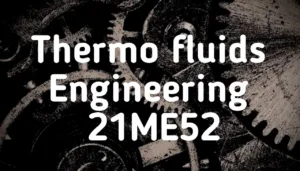
Thermo fluids Engineering 21ME52
Module 1`
Performance Testing of IC Engines: Two-stroke and Four-stroke I.C. engines – Measurement of speed, air flow, fuel
consumption, Measurement of Brake Power and Indicated Power, Performance curves, Heat Balance sheet., Frictional
power: various methods – Willan’s line, Morse test, motoring etc.
Reciprocating Air Compressors: Operation of a single stage reciprocating compressors: work input through p-v
diagram, effect of clearance and volumetric efficiency, adiabatic, isothermal and mechanical efficiencies. Multi-stage
compressor, saving in work, optimum intermediate pressure, inter-cooling, minimum work for compression.
Discussion on application.
Module 2
Refrigeration: Vapour compression refrigeration system; description, analysis, refrigerating effect, capacity, power
required, units of refrigeration, COP, reversed Carnot cycle, vapour absorption refrigeration system and Air refrigeration
system. Use of refrigeration tables and p-h chart. Classification of Refrigerants. Desirable properties of refrigerants.
Psychrometries: Atmospheric air and Psychrometric properties: DBT, WBT, DPT, partial pressure, specific and relative
humidity and relation between the enthalpy and adiabatic saturation temperatures. Construction and use of
psychrometric chart. Analysis of various processes: Heating, cooling, dehumidifying and humidifying. Adiabatic mixing
of stream of moist air. Analysis of summer and winter air-conditioning systems. Discussion on commercial Air
conditioning systems.
Module 3
Introduction to Turbo machines: Classification of Turbomachines, Basic constructional details, Euler’s equation for a
Turbo machine, Impulse & Reaction machine – Axial flow and radial flow machines, utilization factor, degree of reaction
& efficiencies of Turbo machines,
Introduction to positive displacement machines: Classification, comparison with turbomachines. Construction and
working of reciprocating pump, gear and vane pumps. Discussion on engineering applications.
Module 4
Hydraulic Turbines: Classification of hydraulic turbines, Various heads and efficiencies, working principle, Velocity
triangles, work done, efficiencies etc in Pelton wheel, Francis turbine and Kaplan turbine. Draft tubes, Cavitation in
reaction turbines, characteristic curves.Significance of Specific speed and Unit quantities.
Centrifugal Pumps: Main Parts of centrifugal pump, Various heads and efficiencies, work done, minimum speed for
starting centrifugal pump, Classifications- Performance characteristics of centrifugal pumps, Cavitation in pumps and
NPSH. Pumps in series and parallel, casings. Discussion on engineering applications.
Module 5
Centrifugal Fans, Blowers & Compressors: types; velocity triangles, work done and degree of reaction, size & speed;
vane shape & efficiency; vane shape & characteristics; actual performances characteristics; Concept of slip and slip
coefficient. Discussion on engineering applications.
Steam and gas Turbines: Impulse turbines, Staging – expression for work done in a 2-stage velocity compounded turbineeffect
of blade & nozzle losses- Reaction staging- reheat factor- performance characteristics, problems using Mollier’s
chart & introduction to gas turbines.
Have you ever thought abut publishing an ebook or guest authoring on other sites?
I have a blog centered on the same subjects you
discuss and would really like to have you share some stories/information.
I know my visitors would enjoy your work. If you’re even remotely interested,
feel free to send me an e mail. https://WWW.Waste-NDC.Pro/community/profile/tressa79906983/